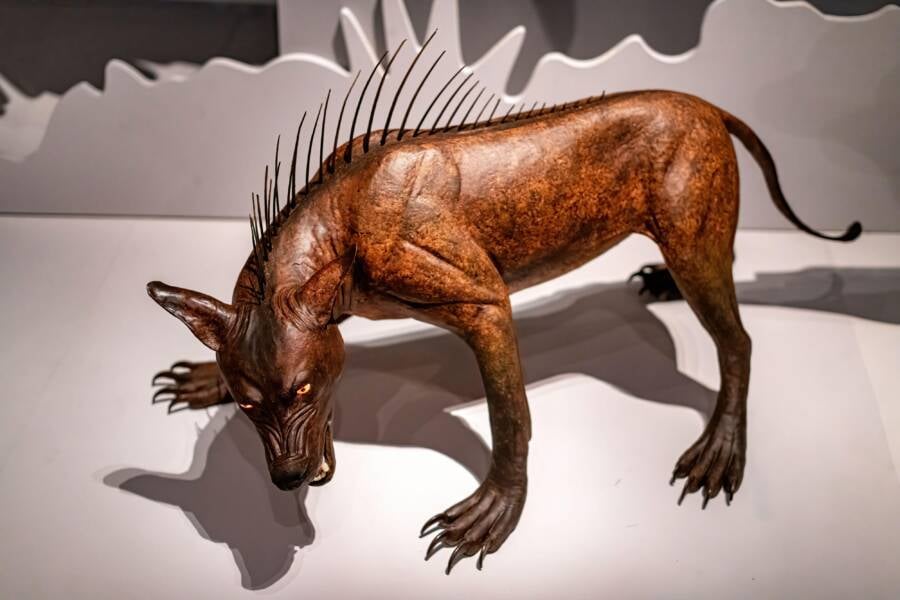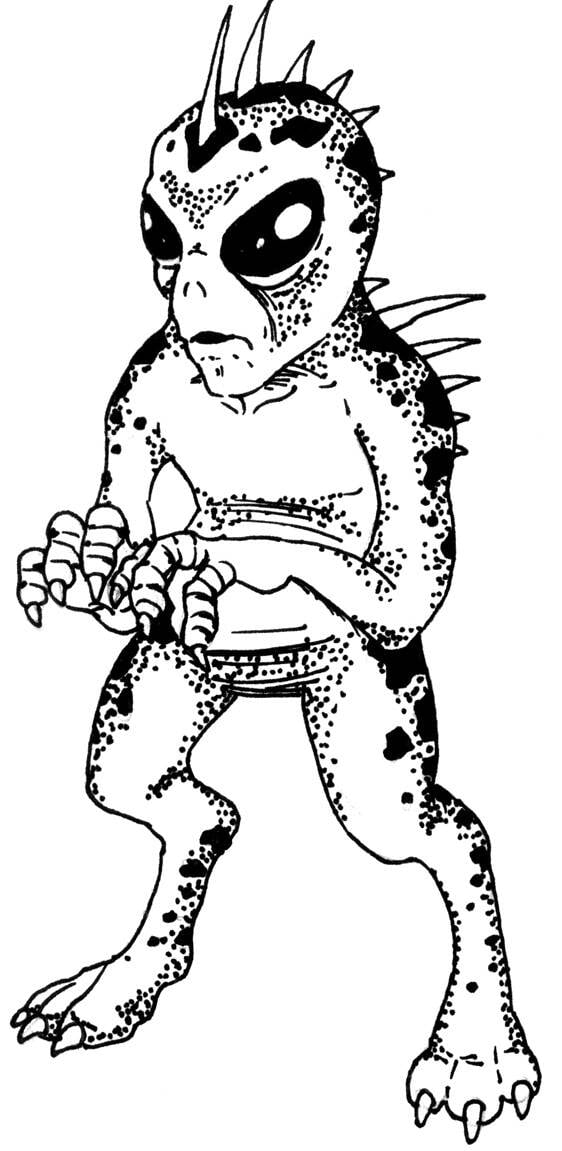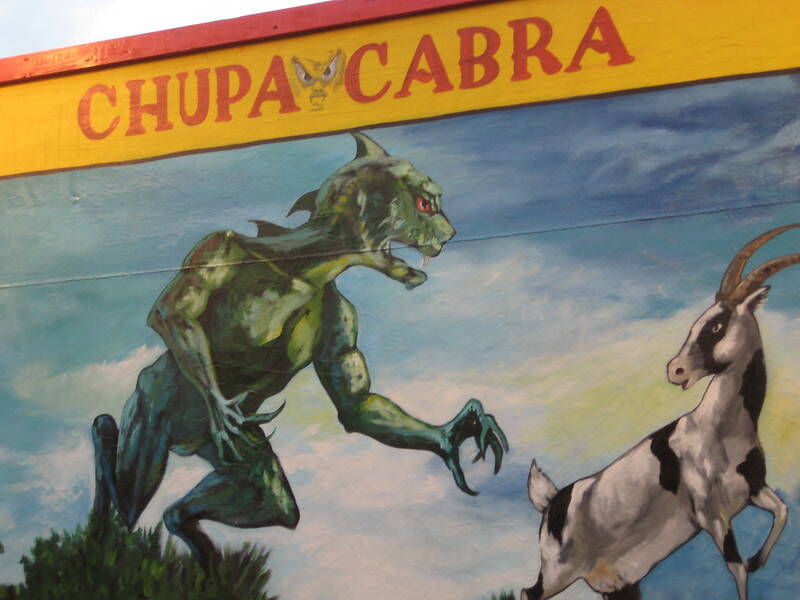Described as a reptilian creature with spines along its back, the Chupacabra is a legendary creature of the American Southwest known for attacking livestock and drinking their blood.
Few cryptids are as storied and as fearsome as the dreaded chupacabra. A blood-sucking creature allegedly the size of a small bear, sometimes with a tail, often covered in scaly skin, and with a row of spines down its back, the chupacabra has been a staple in folklore throughout Mexico, Puerto Rico, and the southwestern United States for decades.
Named after the first animals that it was reported to have killed in Puerto Rico in 1995 (“chupacabra” literally means “goat-sucker” in Spanish), the bloodthirsty creature supposedly then moved on to chickens, sheep, rabbits, cats, and dogs.
Hundreds of farm animals were reportedly turning up dead and drained of their blood, and people had no idea why.

Torontonian/Alamy Stock PhotoIn 1995, Madelyne Tolentino spotted an alien-like creature outside her home in Canóvanas, Puerto Rico. Then the legend of the chupacabra spread.
As soon as word of the attacks on farm animals in Puerto Rico spread, farmers in other countries began complaining of their own attacks. Animals in Mexico, Argentina, Chile, Colombia, and the United States were all dying similarly gruesome deaths, seemingly with no explanation.
To this day, many believe that the chupacabra is to blame and that its disturbing attacks have only continued.
- What Is The Chupacabra?
- What Chupacabras Eat According To The Grisly Reports Of Their Feeding Habits
- Is The Chupacabra Real? Inside The Evidence
- Chilling Accounts Of The Chupacabra From Those Who Claim To Have Seen It Firsthand
- How This Legendary Monster Has Appeared In Pop Culture
- The Science Behind The Myth Of This Blood-Sucking Beast
What Is The Chupacabra?

Wikimedia CommonsAn artist’s rendering based on the first description of a chupacabra.
The chupacabra is, first and foremost, a cryptid, an animal whose existence is regularly disputed or unsubstantiated by science. As with Bigfoot, the Mothman, or the Jersey Devil, many people claimed to have encountered the beast, though such accounts have not been definitively verified.
In fact, sightings of the chupacabra are fairly widespread. The first sightings and descriptions of the creature began in the mid-1990s in Puerto Rico, following reports from local farmers that their goats had been drained of their blood and left dead in their fields.
Farmers who sought to find the party responsible for their goats’ deaths kept a watchful eye, later claiming that a heavy creature with spines stretching down its back and large, alien-like eyes had been spotted in the fields.

Public DomainOne artist’s depiction of the chupacabra, based on witness descriptions from 1995.
Elsewhere, across an area that stretches from Maine to Chile, others have reported seeing a dog-like creature roughly the size of a bear hunting livestock.
Theories about what the chupacabra actually is are also varied. Some claim that it is some horrifying vampirish creature, while others suggest that it may have come from outer space. This debate has caused a level of divide among members of the cryptozoological community, some of whom feel that referring to the chupacabra as an alien diminishes its credibility as a real animal.
Either way, it didn’t take long for stories of the chupacabra to spread.
What Chupacabras Eat According To The Grisly Reports Of Their Feeding Habits
As their name suggests, chupacabras are most commonly associated with feeding on goats — but specifically, just their blood. In other areas, however, they have been said to enjoy other sorts of livestock as well.

Matthew Corrigan/Alamy Stock PhotoAn illustration of a chupacabra recently after draining a goat.
Unlike other predators or purported predators, chupacabras are unique in that they often leave most of their prey untouched. Initial reports claimed that farmers would find their livestock lying in the field, seemingly untouched, only to find the animals entirely drained of their blood.
This detail, though never confirmed by necropsy of any of the allegedly drained animals, became synonymous with the legend of the chupacabra. When these incidents were first reported in the small town of Moca, Puerto Rico around 1975, locals attributed the strange animal deaths to el vampiro de Moca, or “the vampire of Moca.” Some, however, suggested the animal deaths could be the work of some sort of Satanic cult.
It wasn’t until two decades later, when eight sheep were found dead in Puerto Rico, each with three puncture wounds in its chest and reportedly drained of its blood, that people cast blame on a mysterious creature known as the chupacabra.
Is The Chupacabra Real? Inside The Evidence
Before long, word of the chupacabra reached Benjamin Radford, an American writer and general skeptic regarding chupacabra tall tales. Over the next five years, Radford would make it his life’s work to either track down a living specimen or debunk the legend of the chupacabra once and for all.
His years-long journey took him through forests and farmland across South America and the southwestern United States until he finally found what he was looking for – someone who had actually seen a chupacabra up close and personal.

Wikimedia CommonsA dog-like interpretation of the chupacabra.
Her name was Madelyne Tolentino, and she’d seen the chupacabra through a window at her home in Canóvanas, a town east of San Juan, in 1995.
A bipedal creature with black eyes, reptilian skin, and spines down its back, she claimed, was responsible for the animal attacks that were becoming so commonplace in the country. She said it hopped like a kangaroo and reeked of sulphur. Other people that Radford tracked down who claimed to have seen the chupacabra themselves corroborated her description, though some insisted the animal walked on four legs instead of two. Some said it had a tail, while others disagreed.
But for years, Radford’s investigation went nowhere. “I was of course initially skeptical of the creature’s existence,” he told the BBC. “At the same time I was mindful that new animals have yet to be discovered. I didn’t want to just debunk or dismiss it. If the chupacabra is real, I wanted to find it.”

FlickrThe legend of the chupacabra has spread far and wide, leading to many varied interpretations of its appearance.
Soon, another version of the chupacabra — either a distant relative or an evolution — began to emerge. This version was much easier to believe.
Chilling Accounts Of The Chupacabra From Those Who Claim To Have Seen It Firsthand
In place of the reptilian scales covering its body, this new chupacabra had smooth, hairless skin. It walked on four legs and definitely had a tail. It almost looked like a dog.
Then, in the early 2000s, in Texas and elsewhere in the southwestern United States, people started finding dead bodies resembling the chupacabra’s description: hairless, four-legged creatures with burnt-looking skin. About a dozen have turned up since then.
Farmers and ranchers called the authorities having no idea what these creatures could have been, but it turns out the answer was pretty simple: They were mostly dogs and coyotes.
“The reason these animals get identified as chupacabras is because they’ve lost their hair owing to sarcoptic mange,” Radford explained.
Sarcoptic mange, a highly contagious skin disease fairly common in dogs, forces its sufferers to itch away at mites burrowing under the skin. The skin ultimately loses its hair and becomes abnormally thick, and the itching produces nasty-looking scabs.

Wikimedia CommonsAn African wild dog with mange.
A hairless, almost alien-skinned dog? Sounds like a chupacabra.
“Dogs have never attacked my animals,” one Puerto Rican man told The New York Times in 1996 after he lost five of his sheep to exsanguination.
He may have been mistaken. According to the BBC, it’s not uncommon for a dog to bite another animal and then leave it to die, with no apparent injury besides that original bite mark.
So why has the chupacabra legend stuck? Radford thinks it could have something to do with anti-U.S. sentiment in Puerto Rico.
There’s talk on the island of how the U.S. government conducts top-secret scientific experiments in El Yunque rainforest; to some Puerto Ricans, who already feel exploited by the Americans, it isn’t too much of a stretch to think the U.S. could have created a blood-sucking creature in the lab and allowed it to wreak havoc on local farmland.
And what of the sightings, like Tolentino’s, that don’t remotely match the description of a mangy dog? Radford has an explanation for that, too.
How This Legendary Monster Has Appeared In Pop Culture
In 1995, the same year Tolentino first claimed to have seen a chupacabra, Hollywood released the sci-fi horror film Species, which featured a terrifying alien-human hybrid. The film was partially filmed in Puerto Rico, and Tolentino had seen it.

MGMDana Hee and Whip Hubley in Species (1995).
“It’s all there. She sees the movie, then later she sees something she mistakes for a monster,” Radford said. And thanks to the newly popular internet, the legend spread like wildfire.
Scientist Jonathan Jarry agreed with Radford’s assertion, writing in a piece for McGill University:
“[Tolentino’s] original description beggars belief. For a creature she had spotted on the road in front of her house before it disappeared around the corner, the details she remembered are extremely precise… she even said the creature didn’t have an anus. If I glimpsed a never-before-seen animal with spikes down its back, I don’t think I’d be observant enough to look for the presence or absence of an anus.”
Tolentino had even admitted to seeing Species about a month before she allegedly encountered the chupacabra. This makes it impossible to ignore the description she gave Radford and its similarities to the creature design by H.R. Giger as seen in the film — and later media portrayals only muddy the water further.
After all, Species is hardly the only piece of popular media to feature the chupacabra. Two years later, American singer-songwriter and violinist Imani Coppola released her debut album, titled Chupacabra. And while the album didn’t feature any blood-sucking creatures, it certainly didn’t hurt the cryptid’s name recognition. A chupacabra was also the focal point of an episode of The X-Files, and two years after that, an episode of Futurama included a creature called “El Chupanibre,” a clear reference to the chupacabra.
And all of that was before the year 2000. Throughout the early 2000s and into the 2010s, the chupacabra continued to be featured in movies and television shows ranging from sitcoms like Workaholics to dramas like Grimm and even some anime. In fact, the chupacabra has become so commonplace in popular culture that you’d be hard pressed to find someone who hasn’t at the very least heard of it.
But with all of this attention, where has the scientific community landed?
The Science Behind The Myth Of This Blood-Sucking Beast

Wikimedia CommonsBenjamin Radford, one of today’s most widely-known chupacabra scholars.
Ever since the chupacabra urban legend first emerged, cryptozoologists have taken a deep interest in proving its existence. However, curiosity about the creature was not limited to the realm of pseudoscience — in fact, scientists have also investigated the claims, offering potential explanations for the mysterious animal carcasses and the alleged creature behind them.
The mange-ridden dog theory seems to hold the most weight with researchers, based on witness descriptions of the purported chupacabra as well as the known effects of mange. “I don’t think we need to look any further or to think that there’s yet some other explanation for these observations,” entomologist Barry O’Connor of the University of Michigan told National Geographic.
O’Connor spent a good portion of his career studying Sarcoptes scabiei, the parasite that causes mange, a potentially fatal condition that causes an animal’s hair to fall and its skin to shrivel. But while mange could account for some of the reports of the chupacabra’s description, it doesn’t necessarily explain the blood-drained livestock — or does it?
“Animals with mange are often quite debilitated,” O’Connor said. “And if they’re having a hard time catching their normal prey, they might choose livestock, because it’s easier.”
And as for the alleged blood-sucking, O’Connor was rather blunt: “I think that’s pure myth.”

An alleged chupacabra corpse found along Route 72 in Florida.
It wasn’t just O’Connor saying this, either. Loren Coleman, director of the International Cryptozoology Museum in Portland, Maine, agreed that recent chupacabra sightings could be attributed to mangy coyotes, dogs, or coyote-dog hybrids.
“It’s certainly a good explanation,” Coleman said, “but it doesn’t mean it explains the whole legend. In 1995 chupacabras was understood to be a bipedal creature that was three feet tall and covered in short gray hair, with spikes out of its back.”
That doesn’t mean, in Coleman’s mind, that the chupacabra doesn’t exist, however. Rather, she argued that the lines between genuine chupacabra sightings and reports of mangy dogs had blurred to the point where real reports of the mythical creature stopped coming in.
“Because of the whole confusion — with most of the media reporting chupacabras now as dogs or coyotes with mange — you really don’t even hear any good reports from Puerto Rico or Brazil anymore like you did in the early days.”
But the release of Species in the summer of ’95 still complicated those early reports — as did a possibly loose population of rhesus monkeys that had been used in blood experiments in Puerto Rico. As Coleman said, “It could be something that simple, or it could be something much more interesting, because we know that new animals are being discovered all the time.”
Still, 30 years after those initial reports, no one has been able to prove the existence of the chupacabra. So, we are left with what turned out to be a real Occam’s razor of a situation, where the simplest explanation — sightings of mangy dogs and a popular science fiction film — is the most likely.
Is the Chupacabra Real?
The chupacabra remains an urban legend and a piece of largely-Latin American folklore. Since the first reports in 1995, extensive investigations have found no scientific evidence supporting its existence.
Most sightings have been attributed to misidentified animals, such as coyotes or dogs with mange. The legend may have also been influence by popular media, particularly the film Species, which premiered just one month before the most famous chupacabra sightings.
Are There Different Versions Of The Chupacabra?
Yes, over time, two primary descriptions have emerged: a reptilian version and a canine version.
The reptilian version is described as a bipedal creature with reptilian features, sharp spines along its back, and large eyes. This description was prevalent in the initial Puerto Rican reports.
In later reports, however, especially from the United States, the chupacabra is described as a hairless, dog-like animal, often identified as a coyote or dog suffering from severe mange, which causes hair loss and a gaunt appearance.
What Does The Chupacabra Feed On?
The chupacabra is said to feed on the blood of livestock, particularly goats, by biting their necks and draining them dry. It’s name translates to “goat sucker,” though other animals have purportedly been attacked by it.
That said, no necropsy — the only way to verify that a creature was actually drained of blood — has ever confirmed the animals were drained of their blood, thus leaving that claim unsubstantiated.
Where Did The Chupacabra Legend Originate?
The chupacabra legend originated in Puerto Rico in 1995 when a series of mysterious livestock deaths were reported, with animals allegedly found drained of blood and bearing small puncture wounds.
Two decades prior, however, there had been other local rumors of a so-called “vampire of Moca,” with farmers near the small town also reporting small puncture wounds on their livestock. Some theorized this may have been the work of a Satanic cult, but it may have laid the groundwork for the later chupacabra legend.
What Is The Most Famous Chupacabra Sighting?
In August 1995, Madelyne Tolentino reported seeing a creature near her mother’s home in Canóvanas, Puerto Rico.
She described it as a bipedal entity with large eyes, slender limbs, and spikes along its back — features that closely resemble the alien creature “Sil” from the sci-fi horror film Species, which Tolentino had seen prior to her sighting.
This similarity led some researchers to suggest that her description was influenced by the movie, casting doubt on the authenticity of the encounter.
Has Science Debunked The Chupacabra Myth?
Many cases of “chupacabra corpses” have been explained as misidentified animals, particularly dogs or coyotes afflicted with mange — a skin disease caused by mites — that results in hair loss and a gaunt appearance. These animals, weakened by their condition, may have preyed on livestock as it would have required less effort.
Furthermore, analyses of animals purported to be chupacabras have revealed they are typically canids, such as dogs or coyotes, suffering from severe mange. DNA testing has confirmed these identifications, providing no evidence of a distinct, unknown species.
Why Do People Still Believe In The Chupacabra?
Despite scientific debunking, belief in the chupacabra persists due to a combination of cultural factors, media influence, and psychological phenomena. The legend’s rapid spread in the late 1990s coincided with the rise of the internet and sensationalist television programs, which amplified reports and fueled public fascination.
The creature’s mysterious nature and alleged attacks on livestock also tapped into deep-seated fears and superstitions. The power of suggestion and mass hysteria can likewise lead people to interpret ordinary events or sightings of diseased animals as evidence of the chupacabra’s existence.
After learning about the chupacabra, read about other fascinating cryptids like the Bunyip and the Jackalope.





